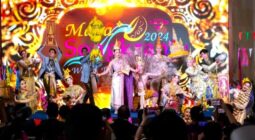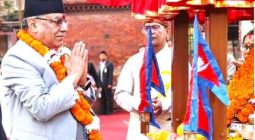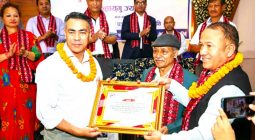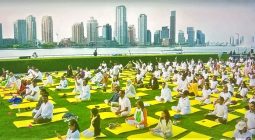Nepal is the land of heady mixture of unique culture proudly preserved; mind boggling adventure and remarkable natural beauty. It is a land where foreigners can revitalize their mind, body and soul amidst scenery.
The peaceful coexistence of multi-religious systems and beliefs is one of the most fascinating aspects of Nepal, where 70 ethnic groups with their own religion, cultures, languages and life-styles exist, and is unique among the cultures of the world.
Nepal’s festivals are dynamic, enthralling. The influx of new sights and sounds are full of energy and life, and rich with genuine excitement.
Festivals are the lenses through which the culture of a country is brought into focus. Many festivals which Nepalese are observing in their traditional way shows that Nepal is rich in its cultural heritage.
Every festival in Nepal traditionally begins with something religious and moves with spontaneous spirit into a pleasant family feast. This is because, for Nepalese, religion has always influenced and has been the core of Nepali culture.
Festivals also offer the visitor a dramatic glimpse of Nepal’s people when they are at their happiest and most relaxed. Nepal’s wonderful cultural heritage is an invaluable resource, one which the Nepalese are striving to preserve.
Nepal’s festivals rooted in the country’s history, mythology and religion, honour and propitiate the multitude of gods, control malicious spirits, or celebrate mythological victories over evil.
Nepalese festivals celebrate religious to historical aspects, agricultural to seasonal changes and legendary fun. Above all, a festival is a social occasion, and an affirmation of the ancient and strong bonds of religion and culture. The festivals of Nepal retain their authenticity, especially in the rural areas; they are not performances put on solely for tourists, but rather are the genuine expressions of vital cultures and religions.
The festivals and the ways of a country observe form the nation’s culture. Festivals in Nepal are reckoned not only as occasions to indulge in eating, drinking and making merry but also as occasions when one is to devote some of one’s time to the worship of and meditation upon gods and goddesses in different forms.
Foreigners used to say that “In Nepal, Every other building is a temple; every other day is a festival”. So, among the many festivals Ghantakarna is one of them which has its own value.
Today (Tuesday July 26) is the day of Ghantakarna Festival. It is also known as Gathaanmuga in Newari, one of the festivals of the Kathmandu Valley.
There are various opinions as to who Ghantakarna was and why the festival has been observed. According to legend, Ghantakarna was a monster. He came to Kathmandu Valley with a view to causing havoc to the people but fortunately he was killed by the great people of the society.
From that time on the festival is said to have been observed. As is the custom prevailing here, on the day of Ghantakarna which falls on the fourteenth of the dark half of the month of Shrawan (July-August), an effigy supposed to be of Ghantakarna made of reeds with leaves on them are set up at the cross roads and from early in the morning urchins standing on the roads ask for “Jagat” (a kind of toll) from the passers-by.
In the evening an untouchable with a bare body painted with obscene figures is made to go from house to house situated within the limits prescribed asking for Jagaat. And after completing his round he is made to hold a bundle of straw burning and set fire to the effigy which is then felled down. The untouchable is then seated on the effigy and the effigy is dragged to the nearest effigy supposed to be the female Ghantakarna and from there the effigies are dragged to the riverside and thrown there.
In the morning the girls hang up their home-made dolls of cloth on the effigy. In the evening people with a view to pacifying the evil spirits leave an earthen pot full of inner husk, onions, garlic, particles of beaten rice flakes, bits of lungs smeared with blood, boiled rice in its rotten condition and burning wicks somewhere at the crossroads. After this nail are struck at the main doors and incense is burnt with a view to warding off evil spirits.

According to another version, Ghantakarna was not a monster but a man who believed more in hard work than in luck and God, and who espoused the cause of the poor more than that of the rich. As he died penniless, tolls were raised to cremate him. As he was far in advance of his time the then society sought to denounce and degrade him by making his effigies to be dragged and burnt by an untouchable or a male member of the lowest caste.
Whatever may be the correct version of the Ghantakarna Festival, one thing is certain that it marks the end of the transplanting of the paddy plants in the Kathmandu Valley and people enjoy this festival after their hard world in the fields.
Those who believe in witchcraft are of the opinion that this is a great day for the witches to invoke the blessing of their deities for the fulfillment of their cherished and design and on the night of the festival the witches go to their respective deities to worship and invoke them.
Generally festival celebrations feature common ingredients: the offering of puja, or worship, to the honoured deity, the carrying of the deity’s image in a rollicking chariot ride, and the flinging of red tika powder and coins into the air in hopes that they will bring luck by landing on the deity or the chariot.
The atmosphere in the streets is imbued with exotic elements: clouds of incense hanging in the air, religious drumming or chanting, and the sound of the flutes, drums, or cymbals of the wandering minstrels. Raucous brass bands may parade through the squares, and evenings may include special gatherings for the singing of devotional hymns or bhajans.
The rich tapestry of the cultural heritage of the country is synthesized in the Kathmandu Valley that represents an epitome of harmony in urban design, elegant architecture and refined culture with concentration of religious monuments unequalled in the world.








